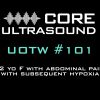A 49-year-old male presents with upper back pain. He describes the pain as sharp, intermittent, and worse with deep breathing or laughing. The pain is very localized, as he points to a specific site on his left upper back. It does not radiate and has been going on since he was in a motor vehicle accident (MVA) one week ago. At that time head CT and chest xray in a local emergency department were normal. He has been prescribed muscle relaxers and NSAIDs, but they do not seem to help. He is concerned that “my spleen is lacerated!” Detailed FAST exam is negative. You then ultrasound his chest where he is hurting…

Answer: Rib fracture with overlying hematoma
The bedside ultrasound clip show an obvious disruption in the bony cortex of the rib, with an associated hematoma overlying it. The fracture is best viewed longitudinally, perpendicular to the typical fracture plane, allowing the sonographer to see both sides of the fracture at the same time. Additionally, there is good lung sliding appreciated, ruling out a pneumothorax at this rib space.
- MVA’s account for over 70% of all blunt chest injuries.1 Rib fractures are by far the most common injury in blunt trauma to the chest, with some studies documenting rib injuries in 78% of these patients.2 These rib injuries are associated with relatively high morbidity and mortality, especially in the elderly.3 Therefore, it is important to have the tools to quickly and correctly diagnose fib fractures.
- CT scan is the gold standard in diagnosing rib fractures, and the more severe traumas will be “pan-scanned,” but what if your patient does not meet criteria for a chest CT?
- Is a single CXR sufficient in diagnosing or ruling out rib fractures? Literature would say no. Recent studies have shown that CXR has low specificities and sensitivities when looking for rib fractures. When compared to ultrasound, CXR is less accurate, sensitive, and specific.5 In another recent study, ultrasound was able to detect 98.3% of rib fractures, while a single CXR only detected 40.7% of the fractures in the same patients.6 In yet another study, ultrasound detected rib fractures in 40% of patients who had normal CXR.
- Not only is ultrasound better in diagnosing rib fracture, but it is also quicker than performing a CXR.6
So next time a patient is brought in with blunt chest trauma and thoracic wall pain, think about pulling out the ultrasound and searching for fractures.
- Sirmali M, Türüt H, Topçu S. A comprehensive analysis of traumatic rib fractures: morbidity, mortality and management. European journal of cardio-thoracic surgery : official journal of the European Association for Cardio-thoracic Surgery. 2003; 24(1):133-8. [pubmed]
- Shorr RM, Crittenden M, Indeck M, Hartunian SL, Rodriguez A. Blunt thoracic trauma. Analysis of 515 patients. Annals of surgery. 1987; 206(2):200-5. [pubmed]
- Calhoon JH, Grover FL, Trinkle JK. Chest trauma. Approach and management. Clinics in chest medicine. 1992; 13(1):55-67. [pubmed]
- Lin FC, Li RY, Tung YW, Jeng KC, Tsai SC. Morbidity, mortality, associated injuries, and management of traumatic rib fractures. Journal of the Chinese Medical Association : JCMA. 2016; 79(6):329-34. [pubmed]
- Rainer TH, Griffith JF, Lam E, Lam PK, Metreweli C. Comparison of thoracic ultrasound, clinical acumen, and radiography in patients with minor chest injury. The Journal of trauma. 2004; 56(6):1211-3. [PMC]
- Pishbin E, Ahmadi K, Foogardi M, Salehi M, Seilanian Toosi F, Rahimi-Movaghar V. Comparison of ultrasonography and radiography in diagnosis of rib fractures. Chinese journal of traumatology = Zhonghua chuang shang za zhi. 2017; 20(4):226-228. [PMC]




